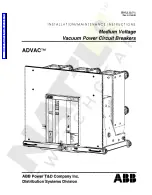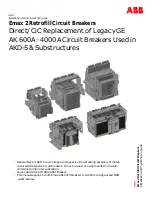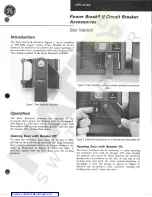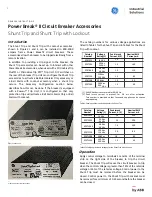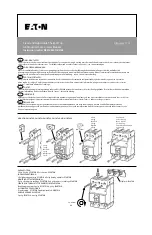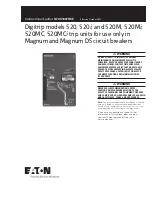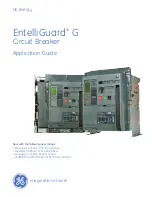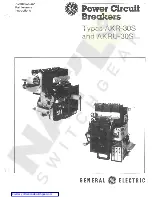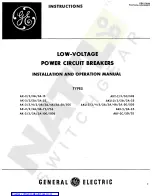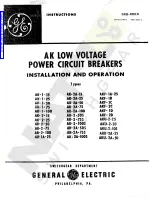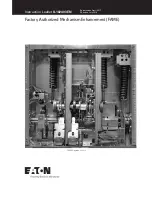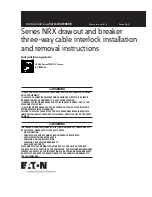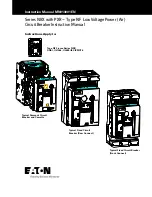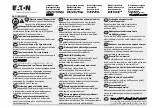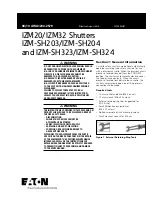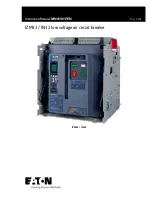
17
SECTION 11—Maintenance
WARNING:
BEFORE ANY MAINTENANCE WORK IS
PERFORMED, MAKE CERTAIN THAT ALL CONTROL
CIRCUITS ARE DE-ENERGIZED AND THAT THE BREAKER IS
REMOVED FROM THE METALCLAD UNIT. DO NOT WORK
ON THE BREAKER OR MECHANISM WHILE IT IS IN THE
CLOSED POSITION WITHOUT TAKING PRE- CAUTIONS TO
PREVENT ACCIDENTAL TRIPPING. DO NOT WORK ON THE
BREAKER WHILE THE CLOSING SPRING IS CHARGED
UNLESS IT IS SECURED IN THAT POSITION BY THE
CLOSING-SPRING GAG.
11.1—General
PowerVac
®
circuit breakers have been designed to be as
maintenance-free as practicable. They include features such
as sealed vacuum interrupters and long-life synthetic greases
which contribute to many years of trouble-free performance
with a minimum amount of maintenance.
11.1.1 Interrupter
The interrupter used in this breaker is a reliable, clean
interrupting element. Since the contacts are contained in a
vacuum chamber, they remain clean and require no
maintenance at any time. The metallic vapors eroded from the
contact surfaces during high current interruption remain in the
chamber and are deposited on metal shields thus insuring a
high dielectric value of the vacuum and the walls of the
interrupter.
11.1.2 Trouble Reporting
Although all reputable manufacturers design their products to
perform satisfactorily with a minimum of problems, the IEEE
Switchgear Committee, an organization of both users and
manufacturers, recognize the need for a common trouble
reporting format. A reproducible copy of this form is included
inside the rear cover of this book and is recommended for use
with any manufacturer’s circuit breakers.
The intent is for each maintenance organization to keep
specific problem files with this information documented.
If the problem is serious or repetitive, a summary should be
sent to the appropriate manufacturer for action. The level of
detail included on the form is considered very desirable so
that the manufacturer’s investigator may more thoroughly
understand and solve the reported problem.
11.2—Service Conditions
The frequency of required maintenance depends on
the severity of the service conditions of the switchgear
application. If the service conditions are mild, the interval
between maintenance operations may be extended to 10
years or 2,500 no load or 200 normal load switching
operations. Mild service conditions are defined as an
environment in which the switchgear is protected from the
deleterious effects of conditions such as:
Salt spray
Changes in temperature that produce condensation
Conductive and/or abrasive dust
Damaging chemicals and fumes
Vibration or mechanical shock
High relative humidity (90%)
Temperature extremes (below –30
°
C or above +40
°
C)
11.3—Fault Interruptions
The erosion rate of the primary contacts in the vacuum
interrupters is very low for normal load switching operations.
However, fault current interruptions at or near the breaker
rating may result in appreciable contact erosion. With frequent
fault interruptions it is necessary to perform maintenance
based on the number of interruptions. After 15 full fault
interruptions the following should be performed:
1. Contact erosion check.
2. Wipe and gap check
3. Vacuum interrupter integrity test.
11.4
—
Contact Erosion
Check in the breaker-closed condition per PRIMARY
CONTACT EROSION section 8.1. When erosion reaches
.125 inch, the interrupter should be replaced.
11.5—Transfer Finger Wear
With the breaker open, examine the moving contact rod
projecting below the transfer fingers (10, Figure 6). Wipe
off the lubricant in order to see the metal surface condition.
The finger locations should present a burnished silver contact
without copper appearance at more than one location. If
copper is visible at more than one location per pole or the
silver plating is torn, the interrupter assembly should be
replaced. Re-lubricate with 0282A2048P009.
11.6—Mechanism
Check all items covered in INSTALLATION and readjust or
tighten hardware as required. Lubricate as recommended
under LUBRICATION.
11.7—Primary Insulation Parts
Using dry, non-linting cloth or industrial-type wipers, clean
accessible insulation surfaces on the interrupter supports
and operating rod insulators. In service locations where
contamination is heavy or external flashovers, have occurred
during interrupter high-potential testing, remove the
interrupter assemblies per the procedure in REPAIR AND
REPLACEMENT and clean the inside surfaces of the
interrupter supports and the outer insulation surfaces of the
interrupters. Removal and reassembly of interrupter
assemblies will normally not require adjustment due to the
design of the interrupter operating rod insulator connection.
They should be returned to the same phase location from
which they were removed.
Summary of Contents for PowerVac
Page 1: ...DEH 40368 Instructions g PowerVac Vacuum Circuit Breaker with ML 20 Mechanism ...
Page 13: ...13 Figure 10 Control switches LCS Switch ...
Page 26: ...26 Figure 14 Continued C Breaker closed spring discharged D Breaker closed spring charged ...
Page 29: ...29 Figure 16 Typical wiring diagram for ML 20 mechanism ...
Page 39: ...Intentionally Left Blank ...































